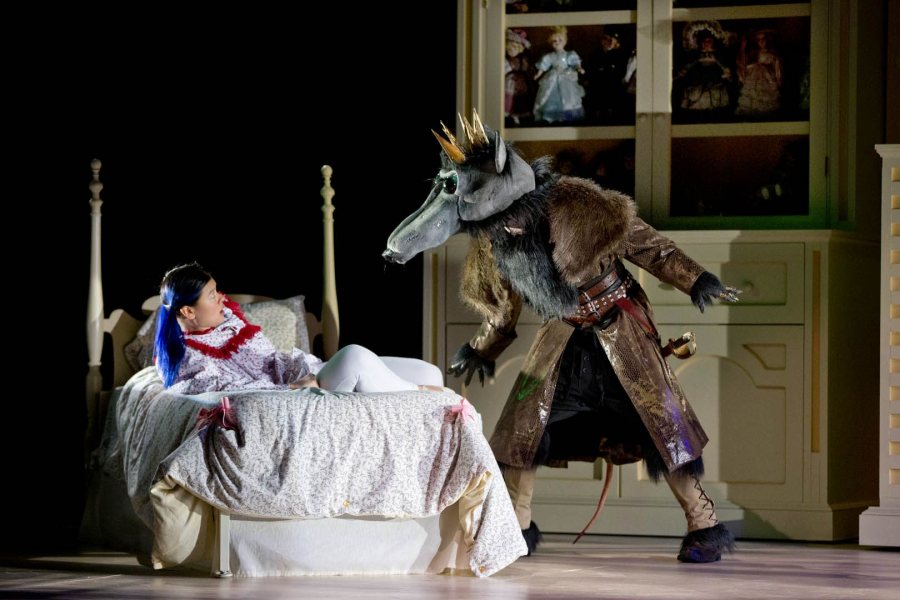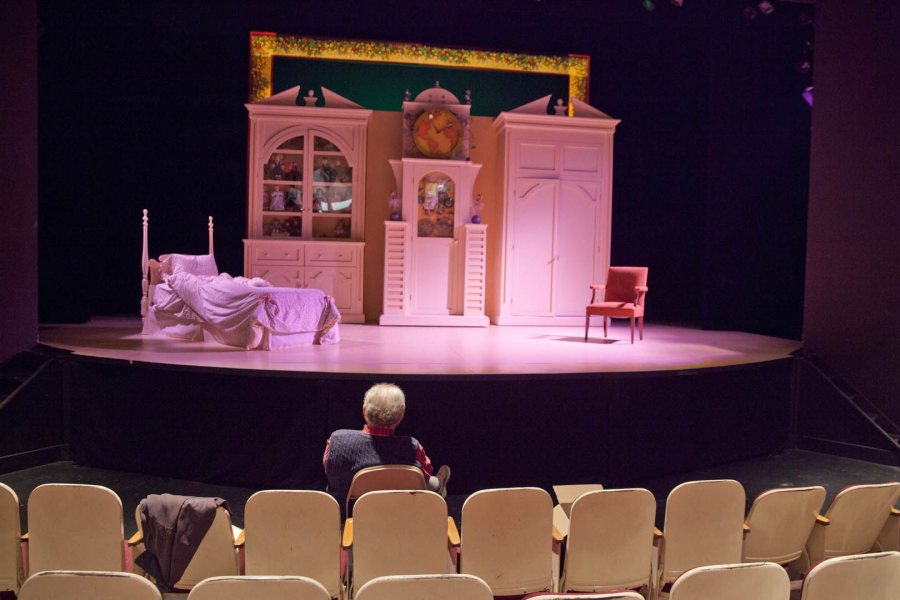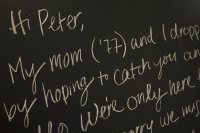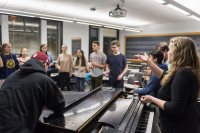![Sukanya Shukla Ô20 as Eurydice, Ethan Winglass Ô19 as Orpheus, Tim Dugan as Father, Cael Schwartz Ô19 as Man; Lord of Underworld, Madison Shmalo Ô19 as Little Stone, Jack Willis Ô19 Loud Stone, Lucas Allen Ô22 as Big Stone, perform during a dress rehearsal of Eurydice at Schaeffer Theater on October 31, 2018.
Eurydice by Sarah Ruhl
Directed by Dana Professor Martin Andrucki
Orpheus is a musical genius, Eurydice is his beautiful bride-to-be; but on the day of their wedding she dies suddenly. Heartbroken, Orpheus follows his beloved to the underworld, where his music persuades the lords of Hades to allow her to return to lifeÑon one condition. Discover what that is in this modern retelling of a classical myth by Sarah Ruhl, twice-nominated for the Pulitzer Prize in drama. ÒRhapsodically beautiful. . . [An] inexpressibly moving theatrical fable about love, loss and the pain of memory.ÓÑThe New York Times.
Please note: Box Office/Lobby for Eurydice is in The Black Box Theater at the rear of Schaeffer.
Thu, Nov 1, 7:30pm
Fri, Nov 2, 7:30
Sat. Nov 3, 5pm
Sun, Nov 4, 2pm
Mon, Nov 5, 7:30pm
Black Box Theater
DIRECTORÕS NOTE
Orpheus, the greatest musician who ever lived, married the beautiful Eurydice. She died on their wedding day, and descended into the Underworld. The grieving Orpheus followed her there, and by the beauty of his music persuaded the Lord of Hades to allow his bride to rejoin the living. It would be easy: Eurydice would simply follow Orpheus on the path back to life. However, there was one condition: if Orpheus looked behind him to assure that Eurydice was following, she would die againÑforever. He did look back; she did die again, forever; and Orpheus spent the rest of his life in mourning.
The classical version of this story focuses on Orpheus and his grief. Our playwright, Sarah Ruhl, puts Eurydice at the center of her drama, examining the crisis of a young woman who must choose between a romantic lover who doesnÕt understand her, and a dead father who does.
Lethe is one of five rivers in the Underworld. The newly dead are dipped in its water to wash away all their memories of life. It encircles the scene of our play.
PRODUCTION STAFF
Stage Manager; Sound Designer...........................................Deon Custard Ô21
Vocal Director......................................................................Katalin Vecsey Technical Director................................................................ Justin Moriarty
Assistant Technical Director..................................................Aidan McDowell Assistant Scenic Designer................................................Kirstin Koepnick Ô21 Assistant Lighting Designer.................................................Amiee Oakes Ô20 Assistant Stage Manager.....................................Luis David Molina Rueda Ô21 Costume Shop Supervisor... .....................................................Carol Farrell
Costume Shop Crew........................................Jade Zhang '21, Julia Nash '21 ............................Brooke Jandreau '20 Sara Hollenberg Õ19, Talia Sperduto '21 ...............................Jamie Kelleher Õ19, Sukanya Shukla Õ19, Kate Loughlin '22 Wardrobe........................................Brooke Jandreau Õ20, Sara Hollenberg '19 Foley Art.........................................................Henry King Ô22, Noah Pott Ô22 Light Board Operator..........................................................Aimee Oakes Ô20
Sound Board Operator............................................................Henry King Ô22
Carpenters...........................Quinn Healy '19, Haley Crim Õ19, Olivia Gomez '22 ...............................Julia Gutterman '20, Madison Hallowell '20, Henry King '22 .............Michael Hartnett '20, Julie Jesurum '22, Erin Lyons '21, Patrick Reilly '21 ........................Luis David Molina Rueda '20, Yilun Wu '22, Carlo Cremonini '21 ........Kei K. Ching Õ19, Kirstin Koepnick Ô21, Giulia Andronico de Morais Salles '22 ............................Deon Custard '21, Xavier Hayden '19, Gabriele Gucagaite '21 Animation......................................................Mayele Alognon Ô20, Sophie Gerry Ô20 ................................Daisy Diamond Ô19, Maddy Hallowell Ô20, Kirstin Koepnick Ô21 Run Crew..........................................Kei K. Ching Ô19, Gabriele Gucagaite Ô21
Box Office.....................................Alexandra Gilbertson '22, Georgia Moses Õ21 Poster Design............................................................................Lily Kip Ô19 Social Media ..............................................David Garcia Ô20, Nicky Longo Ô21 Custodians......................................................Hussein Kulow, Ed Woodhead
Special Thanks to: John Blanche e; John Corrie](https://www.bates.edu/news/files/2018/11/181031_Eurydice_2870-200x133.jpg)
In world premiere, ‘Marie and the Nutcracker’ updates familiar story

Keila Ching ’18 of Honolulu portrays Marie, and Sam James ’17 of Raleigh, N.C., is the Mouseking in Dana Professor of Theater Martin Andrucki’s “Marie and the Nutcracker.” (Phyllis Graber Jensen/Bates College)
With shows through Monday, a classic holiday tale gets a modern twist in the current mainstage theater production at Bates.
Martin Andrucki, Charles A. Dana Professor of Theater, has adapted German writer E.T.A. Hoffmann’s original story about a magical nutcracker to create a play that’s set in the present day and titled Marie and the Nutcracker.
Every Christmas season, audiences around the world flock to productions of the classic 1892 ballet The Nutcracker, the tale of a young girl, an evil Mouseking and the Nutcracker-turned-prince. The ballet was scored by Pyotr Ilyich Tchaikovsky and choreographed by Marius Petipa and Lev Ivanov.
Fewer people, however, are familiar with Hoffman or his children’s story The Nutcracker and the Mouse King, upon which the famous ballet is based. (Where the ballet’s heroine is named Clara, she is called Marie in Hoffmann’s story, and Andrucki’s adaptation retains that name. In Hoffmann’s original, Clara is Marie’s doll.)
Setting out to write a holiday play, Andrucki took inspiration from Hoffmann’s original tale.
“I had this idea that it would be interesting if we had another Christmas play, you know, besides A Christmas Carol. And the original Nutcracker story seemed like a fairly obvious choice,” he says. Because of the ballet, it’s “familiar to everyone.”
But while ballet doesn’t figure in Andrucki’s play at all, the playwright has kept much from Hoffmann’s plot that was lost en route to the ballet.
As he studied Hoffmann’s novella, Andrucki noticed elements that would translate well onto the stage as a play. He saw an opportunity to tell Hoffmann’s full story and a chance to add reflection on the way that the Christmas holidays are celebrated today.
Hoffmann’s story is both darker and more complex than the ballet. As in the ballet, a girl is given a nutcracker by her aloof uncle Drosselmeier just before Christmas. At night, she sees the nutcracker come to life in her bedroom, but her family does not believe her.
Andrucki’s students will learn “how important it is to have a sense of stagecraft as part of your equipment as a writer.”
The next day, Drosselmeier tells her a story, “The Tale of the Hard Nut,” explaining the history of the mutual animosity between the evil Mouseking and the Nutcracker, who was once a man. Drosselmeier’s story gives Marie the chance to change the Nutcracker’s fate.
In Andrucki’s version, Marie and her younger brother are children in 2015. Her brother asks for the latest video games for Christmas, and her mother and older sister bemoan the commercialization of the holiday season.
In these scenes, the play is rooted in reality. Only when Drosselmeier tells the story of the nutcracker does the play enter, as Andrucki puts it, the period of “once upon a time.”
The Bates set and lighting will reflect the shifts in the play between modern reality and timeless fantasy. What audiences will experience “oscillates back and forth, just as the script does,” says Andrucki, “between things that are pretty realistic and things that are pretty fanciful.”
Andrucki also directs this production. Directing his own work, he says, creates both challenges and opportunities. “I’m finding it a challenge to try and remain objective about my own work, like a director has to be,” he says.
Only when Drosselmeier tells the story of the nutcracker does the play enter the period of “once upon a time.”
However, his double role gives his students a firsthand glimpse into the ongoing nature of the writing and rewriting process. “They learn something about how a play evolves during production, and how someone who’s a playwright changes or revises the script in order to make it work onstage,” he says. “And how important it is to have a sense of stagecraft as part of your equipment as a writer.”
The cast includes Keila Ching ’18 of Honolulu as Marie and Nate Stephenson ’18 of Ellsworth, Maine, as the Nutcracker; Amanda San Roman ’17 of Belle Terre, N.Y., as Marie’s younger brother Freddy, Audrey Burns ’17 of Topsham, Maine, as her older sister Louise, Brennen Malone ’17 of Philadelphia as her father, and Sam James ’17 of Raleigh, N.C., as the Mouseking; and Mara Woollard ’16 of Portsmouth, Va., as Marie’s mother and Colin McIntire ’16 of Darien, Conn., as Drosselmeier.
Michael Reidy, senior lecturer and managing director of theater and dance, is the lighting and technical directory. Associate Professor of Theater Christine McDowell designed the costumes, and Judy Gailen created the play’s scenic design.
Although the production includes no dancing, Andrucki says it aims to entertain audiences who are familiar with the classic ballet production. “The more you know about the Nutcracker,” he says, “the more I think you will see the contrasts and humorous parallels between the dance and the play.”
Andrucki says the play is intended for audiences of all ages.
“I hope people just have a good time watching this. I hope they find it’s fun, and I hope they get a new perspective on the whole Nutcracker phenomenon and maybe a fresh perspective on the whole Christmas experience.”





